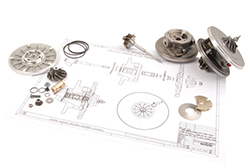
Parts Design Improvements -There has been much discussion within the automotive repair industry about the differences between using OEM parts and the aftermarket equivalent repair parts. In this article, with a focus on turbochargers; we explore the benefits associated with using high quality repair parts and why such parts can actually improve a turbo repair.
The automotive aftermarket helps keep vehicles on the road by providing consumers with the choice. In today’s market, garages also have the choice between a wide range of turbo repair specialists.
What options are available?
As with many automotive components, it is likely that the original turbocharger will fail during the vehicles lifecycle. The options are; to repair or remanufacture the failed turbo with aftermarket components, replace the entire unit with a brand new OE turbocharger, or more so in today’s market, with an aftermarket equivalent complete unit. What is less obvious is a thorough understanding of the different options available. Where do you start to try and understand the ever increasing influx of repair parts suppliers? Should you choose OE over aftermarket equivalents, they are certainly more expensive but are they any better?
What is the difference between parts?
In today’s crowded marketplace there are many aftermarket parts suppliers. Some specialise in specific parts, such as turbocharger parts, and others produce a wide range of general automotive components. More variety means more choice and a wider range of prices, but more importantly, varying levels of quality.
Aftermarket parts are generally less expensive than OEM parts; how much you save, however, varies by brand and also by the quality of the components. It is important to understand that there is a significant difference between top quality aftermarket parts and budget repair parts.
Very low cost aftermarket parts are inferior and are often produced using lower-grade materials and less stable manufacturing processes. This results in unreliable parts. It is important to understand the mentality of a low cost manufacturer; if you pay a very low price, you should expect to get a few bad parts in every hundred. That’s why they are cheap!
The only way to avoid this is to use high quality repair parts from a reputable manufacturer. What customers often don’t realise is; a high quality aftermarket manufacturer does not just bring more competitively priced options over the OEM equivalent; they often bring added benefits and improvements over the original design, giving an improved product at a better price.
Part design improvements for better performance
As a leading manufacturer for replacement turbocharger parts, here Melett’s Engineering Manager, Mark Tindall, gives us some examples of where aftermarket parts have actually been improved over the OE equivalent, producing an improved aftermarket turbocharger.
‘Where an OE manufacturer will incorporate improvements into newer turbo designs, turbos that are entering the aftermarket at 4-5 years old will still incorporate the original design specification,’ says Mark.
‘Due to homologation, once a turbocharger design is approved by a vehicle manufacturer; the turbo OEM’s cannot deviate from this original approved design without seeking a revised approval; which is very expensive for the vehicle manufacturer and not considered necessary. Aftermarket manufacturers are not restricted in this way.’
Quality aftermarket manufacturers, such as Melett, have the benefit of hindsight from analysing service failures in the market, and also the future knowledge of the latest developments in materials and manufacturing technology.
Combining this knowledge with experience allows Melett to correct inherent design issues. As well as upgrade old turbo designs using new materials and improved component designs. The result is an improved aftermarket design over the original design.
Here are some examples:
- BV/KP35/39 Thrust Flinger – Improved Twin Ring Design– When the original KP35 turbo came out in the early 2000’s, it was a flatback designed compressor wheel with one piston ring groove on the flinger. The original design was prone to oil leaks at the compressor end as the piston ring seal wasn’t good enough. Borg Warner improved the design in later models by moving to a twin ring design. However, the original turbos produced with a single piston ring remain, single ring, and have never changed. All Melett KP35 CHRA’s are supplied as standard with twin ring design. Click here for more information.

- 360° Thrust Bearings in Place of 180° – The original BV/KP35/39 thrust bearing was the 3 pad, 180 degree design. Due to the open thrust pad area oil retention was an issue. In newer OE turbo applications, this has been replaced with the 360 degree design; resulting in better oil pressure and lubrication. Melett only use the 360 degree thrust bearing design in all BV/KP35/39 core assemblies, giving the turbo longer life. Click here for more information.
- K03/4 Thrust Bearing – Melett Hot Forged vs OE Stamped-The original K03/4 thrust bearings are produced using a stamped strip manufacturing process, which has limited strength. Melett produces the same part using the hot forged method; allowing use of a much superior high tensile silicon brass material which is common in most new applications.‘Improved parts, like the above examples, will enhance the life of the repaired or remanufactured turbo. The result is a repaired turbo that performs better than the original unit fitted to the vehicle; or the OE equivalent that is still identical to the original design due to homologation. OE parts are not always the highest quality option even though they are usually the highest price,’ says Mark. Click here for more information.

- GT15-25 Slender Shafts – Increased Radius to Reduce Stress-In recent years, there has been a general move towards a full back face turbine wheel casting design. This design gives a significantly stronger blade, preventing fatigue failure of the individual turbine blades. In applications where the casting failure is commonly seen, Melett has changed the shaft and wheel design to include a full back face casting. This reduces the chance of fatigue failure and generally gives a longer life in harsh applications. Click here for more information.
- GT15 Seal Plate – Extra Strengthening Ribs – Seal plates are prone to failing around the compressor wheel diameter, to improve the strength the Melett 1102-015-300 seal plate has been designed to incorporate extra strengthening ribs to help prevent failures. Click here for more information.
- GT15 Nozzle Assembly – Solid Vane Design– During the design review of the GT15 nozzle assembly, Melett Engineers concluded that the solid vane design for the 753420 GT15 nozzle ring, rather than the original welded strip metal design, was the preferred route for the aftermarket providing a stronger repair solution. Click here for more information.

Making the right choice
Mark continues, ‘A key point to remember is that unlike OEM parts, not all aftermarket parts are produced equally and the quality of parts available varies depending on the type of manufacturer. Aftermarket parts can save you a lot of money. However, with so many options available for turbocharger repair, it is essential that you choose a repair specialist who understands the differences between the options available. The extra labour costs associated with making the wrong choice are often very significant’.


